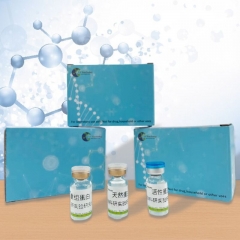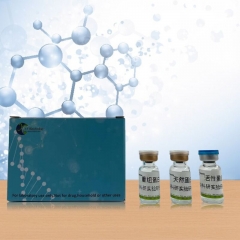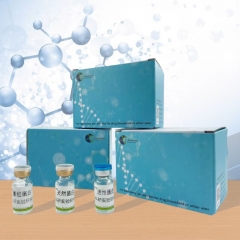Active Fibroblast Growth Factor 1, Acidic (FGF1)
酸性成纤维细胞生长因子(FGF1)活性蛋白
[ PROPERTIES ]
Source: Prokaryotic expression. Host: E. coli
Residues: Met1~Asp155
Tags: Two N-terminal Tags, His-tag and GST-tag
Purity: >98%
Buffer Formulation: 20mM Tris, 150mM NaCl, pH8.0, containing 0.05% sarcosyl
and 5% trehalose. Applications: Cell culture; Activity Assays; In vivo assays. (May be suitable for use in other assays to be determined by the end user.)
Predicted isoelectric point: 6.5
Predicted Molecular Mass: 47.3kDa
Accurate Molecular Mass: 55kDa as determined by SDS-PAGE reducing conditions. Phenomenon explanation:
The possible reasons that the actual band size differs from the predicted are as follows:
1. Splice variants: Alternative splicing may create different sized proteins from the same gene.
2. Relative charge: The composition of amino acids may affects the charge of the protein.
3. Post-translational modification: Phosphorylation, glycosylation, methylation etc.
4. Post-translation cleavage: Many proteins are synthesized as pro-proteins, and then cleaved to
give the active form.
5. Polymerization of the target protein: Dimerization, multimerization etc.
[ USAGE ]
Reconstitute in 20mM Tris, 150mM NaCl (pH8.0) to a concentration of 0.1-1.0mg/mL. Do not vortex.
[ STORAGE AND STABILITY ]
Storage: Avoid repeated freeze/thaw cycles.
Store at 2-8ºC for one month.
Aliquot and store at -80ºC for 12 months.
Stability Test: The thermal stability is described by the loss rate. The loss rate was determined by accelerated thermal degradation test, that is, incubate the protein at 37°C for 48h, and no obvious degradation and precipitation were observed. The loss rate is less than 5% within the expiration date under appropriate storage condition.
[ SEQUENCE ]

[ ACTIVITY ]
FGF1 (Fibroblast growth factor 1) is a member of FGF family, which plays an important role in the regulation of cell survival, cell division, angiogenesis, cell differentiation and cell migration. FGF1 is thought to stimulate the proliferation of 3T3 fibroblasts, besides, human FGF1 and mouse FGF1 shares similarities in amino acid sequence with the identity of 96%. Thus, a cell proliferation assay was conducted to detect the bioactivity of recombinant human FGF1 using 3T3 fibroblasts. Briefly, 3T3 cells were seeded into triplicate wells of 96-well plates at a density of 2,000 cells/well and allowed to attach overnight, then the medium was replaced with serum-free standard DMEM prior to the addition of various concentrations of FGF1. After incubated for 48h, cells were observed by inverted microscope and cell proliferation was measured by Cell Counting Kit-8 (CCK-8). Briefly, 10µL of CCK-8 solution was added to each well of the plate, then the absorbance at 450nm was measured using a microplate reader after incubating the plate for 1-4 hours at 37°C. Proliferation of 3T3 cells after incubation with FGF1 for 48h observed by inverted microscope was shown in Figure 1. Cell viability was assessed by CCK-8 (Cell Counting Kit-8 ) assay after incubation with recombinant FGF1 for 48h. The result was shown in Figure 2. It was obvious that FGF1 significantly increased cell viability of 3T3 cells.


[ IDENTIFICATION ]

Figure 3. Gene Sequencing (extract)

 在线客服1号
在线客服1号












